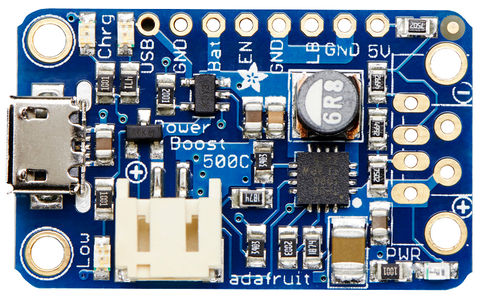PowerBoost-500-Chargeur-PinOut
Brochage
Pour de nombreuses personnes, le PowerBoost 500 Chargeur peut être vu comme un accu rechargeable par microUSB et disposant d'une sortie alimentation USB. AdaFruit a cependant ajouté des breakouts bien utiles... voyons un peu ce qu'il y a sous le capot!

Crédit: AdaFruit Industries www.adafruit.com
Broches d'alimentation
There's three power voltages, the USB input for charging the battery (4.75-5.25V whatever is coming out of the USB port), the battery itself (3-4.2V) and the output (5-5.2V)
- USB: this is the micro USB 5V power pin. It's the pin that is used to charge the battery, NOT the output power! You can use this if you want to grab power from the microUSB port when it is plugged in
- GND: this is the power ground. This boost converter is not 'isolated' - the ground input is the same as the ground output
- BAT: this is the battery input, connected directly to the JST connector. For most Lithium batteries, this will range from 3.0V when near-dead to 4.2V when fully-charged. Higher voltages will let you draw more current and in general, are more efficient. Try to keep the wires going to this pin nice and short - 3" or less is best!
- 5V: this is the boosted output. When the board is running, the voltage will be 5.2V approximately. It may dip down to 5V as the current draw starts to go up (over 500mA). When the board is disabled, this output is 'floating' but you should still try not to apply a voltage to it while the board is disabled. There's a green LED connected to this pin which will let you know when there's power output
Broches de contrôle
There's two 'control' pins.
- EN: this is the 'enable' pin. By default it is pulled 'high' to VBAT. To turn off the booster, connect this pin to ground. The switch can be as small as you like, it is just a signal. Contrast this to an inline power switch which would have to be able to handle up to 2A of current! When the chip is disabled the output is completely disconnected from the input.
- LBO: not a leveraged buy out! this is the Low Battery Output. By default it is pulled high to BAT but when the charger detects a low voltage (under 3.2V) the pin will drop down to 0V. You can use this to signal when its time to shut down or alert the user that the battery is low. There is also a red LED connected to this pin.
Led LEDs
There are four onboard LEDs.
- The Blue LED sits next to the USB connector socket, and indicates the 5V output power state.
- The Red LED is next to the battery JST port and indicates when the battery voltage is below 3.2VDC (Low Battery Output)
- The Yellow LED is next to the microUSB connector and indicates when the battery is being charged
- The Green LED is also next to the microUSB connector and indicates when the battery is done charging (all full)
Connexion Accu et USB
You can connect a battery to the breakout strip or to the JST connector. All of Adafruit batteries come with JST cables that will plug in nicely so we strongly suggest that. Watch the polarity of the cable! the + and - markings next to the JST will let you know which way is which.
The USB connector can be soldered on to create a portable 'USB power pack'. The two data lines on USB have resistor dividers that match Apple charger values so that you can plug any iOS device in to charge. 99% of other phones, devices and tables are totally cool with these resistors as well. You can always short the D+ and D- lines if you happen to have a phone that wants shorted data lines.
If you don't want a USB connector attached, there are two holes that are designed for a 3.5mm spaced terminal block (not included)
Tutoriel Adafruit PowerBoost 500 Charger créé par Lady Ada pour AdaFruit Industries.
Tutoriel traduit par Meurisse D. pour MCHobby.be
Traduit avec l'autorisation d'AdaFruit Industries - Translated with the permission from Adafruit Industries - www.adafruit.com
Toute référence, mention ou extrait de cette traduction doit être explicitement accompagné du texte suivant : « Traduction par MCHobby (www.MCHobby.be) - Vente de kit et composants » avec un lien vers la source (donc cette page) et ce quelque soit le média utilisé.
L'utilisation commercial de la traduction (texte) et/ou réalisation, même partielle, pourrait être soumis à redevance. Dans tous les cas de figures, vous devez également obtenir l'accord du(des) détenteur initial des droits. Celui de MC Hobby s'arrêtant au travail de traduction proprement dit.